Intel Core i5-13600K vs AMD Ryzen 7 7700X and Ryzen 5 7600X Face Off
Zen 4 vs Raptor Lake, Fight!

The Intel Core i5-13600K vs AMD Ryzen 7 7700X and Ryzen 5 7600X rivalry is a heated battle in the heart of gamer country — the mid-range price points — with Intel's 13th-Gen Raptor Lake x86 hybrid architecture squaring off against AMD's chiplet-based Zen 4 Ryzen 7000 family. These two fundamentally different approaches have shaken up our list of the best CPUs for gaming as the Intel vs AMD battle enters a new phase.
The Core i5-13600K’s pricing lands between the Ryzen 7 7700X and Ryzen 5 7600X, so it’s challenged from both sides of the pricing spectrum. For Raptor Lake, Intel increased the number of small E-cores across its product stack, thus giving the Core i5 K model a total of 14 cores (a first for Core i5), and improved the chips' clock rates and cache to boost performance.
AMD's Ryzen 7000 chips come to market with an entirely new architecture and process node. The company uses only full-fledged Zen 4 cores that deliver 13% higher IPC, the TSMC 5nm process, faster clock speeds, and a new AM5 platform that drastically improves power delivery. All told, the Ryzen 7 and 5 processors represent a big step forward over the Zen 3 predecessors.
Both Ryzen 7000 and Raptor Lake's modern connectivity technologies bring big increases in throughput via DDR5 memory and PCIe 5.0 interfaces, but Intel also chose to continue to support DDR4 memory to offer a less-expensive path for builders. Meanwhile, AMD's decision to support only DDR5 has proven to be a pricing pain point.
Intel has also aggressively priced its newest silicon. As a result, the $319 Core i9-13900K's pricing contends with the $349 Ryzen 7 7700X and the $249 Ryzen 5 7600X, but the Intel chip is incredibly competitive in all manner of work against the more expensive 7700X, not to mention having lower overall platform costs.
Below we've taken the Core i5-13600K vs Ryzen 7 7700X and Ryzen 5 7600X rivalry through a six-round faceoff to see which chips take the crown in our gaming and application benchmarks, along with other key criteria like power consumption and pricing. Let's see how they stack up.
Features and Specifications: Intel Core i5-13600K vs AMD Ryzen 7 7700X and Ryzen 5 7600X
| Row 0 - Cell 0 | Price | Cores / Threads (P+E) | P-Core Base / Boost Clock (GHz) | E-Core Base / Boost Clock (GHz) | Cache (L2/L3) | TDP / PBP / MTP | Memory |
| Ryzen 7 7700X | $349 ($399) | 8 / 16 | 4.5 / 5.4 | - | 40MB (8+32) | 105W / 142W | DDR5-5200 |
| Core i5-13600K / KF | $319 (K) - $294 (KF) | 14 / 20 (6+8) | 3.5 / 5.1 | 2.6 / 3.9 | 44MB (20+24) | 125W / 181W | DDR4-3200 / DDR5-5600 |
| Ryzen 5 7600X | $249 ($299) | 6 / 12 | 4.7 / 5.3 | - | 38MB (6+32) | 105W / 142W | DDR5-5200 |
Intel’s Core i5-13600K has a $319 recommended list price for the full-fledged model, and the graphics-less KF model goes for $294. You can often find the Intel chips roughly around that pricing at retail, but we can’t say the same for the AMD processors — the Ryzen 7 7700X has a suggested $399 price tag, while the Ryzen 5 7600X is officially $299. However, you can find these chips for about $50 less, or around $349 and $249, respectively. AMD tells us it is currently running a holiday promotion, meaning these aren’t official price cuts, but these chips have maintained this pricing for about a month. Additionally, AMD’s suggested pricing often has little to do with reality, so we think we’ll continue to see these chips in this price range. You should keep this in mind and make sure to check current pricing.
Intel still uses the 'Intel 7' process node for Raptor Lake but leveraged a newer revision of the silicon (the fifth) to push clock speeds higher while improving power efficiency. Intel's $319 fourteen-core Core i5-13600K comes with six hyper-threaded P-cores and eight single-threaded E-cores (20 threads). That's an increase of four additional E-cores over the previous-gen Core i5-12600K, equating to more threaded horsepower. The 13600K's P-cores come with a 3.5 GHz base (a 200 MHz decline) and a 5.1 GHz boost (+200 MHz). Meanwhile, the E-cores now have a 2.6 GHz base (+200 MHz) and stretch up to 3.9 GHz (+300 MHz). That means there are more E-cores, and you also get more out of each core.
The 13600K is also equipped with 24MB of L3 cache (+4MB) and 20MB of L2 (+10.5MB) and drops into existing 600-series motherboards or the new 700-series models. The chip comes with the integrated UHD Graphics 770 engine with 32 EUs that boost up to 1.45 GHz. You can also save some cash with the Core i5-13600KF, which is identical but lacks the Intel UHD Graphics 770 engine, for $294.
Intel's chips now have a Processor Base Power (PBP) value in place of TDP and a secondary Maximum Turbo Power (MTP) value that denotes the highest power level during boost activity. The 13600K comes with 125W PBP (base) and 181W MTP (peak) power ratings, which is a 31W higher MTP than the previous-gen model. You should also be aware that Intel's default boost duration for all K-series chips is unlimited. This means the chip can always operate at the 181W MTP when it is under load, though the actual power use will vary with application intensity.
AMD etches the Ryzen 7 7700X and Ryzen 5 7600X on the TSMC 5nm process, yielding drastic gen-on-gen clock rate improvements. The eight-core 7700X comes with a 4.5 GHz base (+1.1 GHz) and a 5.4 GHz boost (+800 MHz). The six-core Ryzen 5 7600X has a 4.7 GHz base (+1 GHz) and a 5.3 GHz boost clock (+700 MHz). AMD's new AM5 platform has significantly improved power delivery, allowing the company to extract more performance during strenuous multi-threaded workloads. Notably, the Ryzen models support hardware acceleration of AVX-512 instructions, whereas the 13600K does not.
The increased power draw has an effect, though — the 7700X and 7600X have a 105W TDP rating and a max power draw of 142W, the highest power consumption of the Ryzen 7 and 5 chips yet. It's also much higher than the previous-gen’s 65W TDP rating. The Ryzen chips are designed to use the full thermal headroom available to deliver more performance, so they can safely operate at 95C under heavy load. We don’t see that much with the Ryzen 7 and 5 models, though.
The AM5 platform also marks AMD’s first mainstream LGA socket in recent history and supports the DDR5-5200 and PCIe 5.0 interfaces, largely matching Intel on the connectivity front. However, AMD's AM5 platform only supports DDR5 memory, while Intel's 600- and 700-series chipsets support DDR5-5600 and DDR4-3200. AMD's decision to go all-in on DDR5 is one of the key reasons its platform costs are higher than Intel's — DDR5 still carries premium pricing but doesn't deliver large performance gains over DDR4 in most types of work, including gaming. The AM5 platform is new, so the Ryzen 7000 chips aren't backward compatible with older AM4 motherboards. AMD will support AM5 until 2025+, meaning it should have an extended upgrade pathway.
The 7000 series marks the arrival of an integrated GPU for all of the mainstream Ryzen processors, a first. AMD designed the RDNA 2 iGPU to provide basic display output capabilities, so you shouldn’t expect it to support any meaningful gaming. The RDNA 2 iGPU has two compute units, 4 ACE and 1 HWS. This is an important step forward for AMD's chips, as it helps in the OEM market and allows you to power a display or troubleshoot if you have an issue with your discrete GPU.
Winner: Tie
The Intel Core i5-13600K vs AMD Ryzen 7 7700X and Ryzen 5 7600X battle yields a tie in this category. Both chips support DDR5 and the PCIe 5.0 interface, meaning neither has an inherent connectivity advantage. However, Intel has the advantage of backward compatibility for DDR4, enabling lower-cost motherboards and memory for value seekers.
While AMD's new AM5 platform only supports pricey DDR5 and carries a premium over the Intel motherboard ecosystem, it does afford forward compatibility — AMD plans on supporting the AM5 platform until 2025+. Meanwhile, Raptor Lake drops into previous-gen 600-series motherboards, providing a value option if the board has the correct BIOS. Still, the newer 700-series motherboards officially represent the end of the line for the LGA 1700 socket. However, signs point to a refreshed family of Raptor Lake chips on the horizon, meaning there's a chance for one more generation of upgrades in the LGA 1700 platform.
Given its new hybrid architecture with two types of cores, Intel's core counts aren't directly comparable to AMDs due to their different capabilities. Our performance results will dictate the value of the overall designs.
Gaming Benchmarks and Performance: Intel Core i5-13600K vs AMD Ryzen 7 7700X and Ryzen 5 7600X
Remember, this article is an overview of our much more in-depth testing in our Intel Core i9-13900K and Core i5-13600K Review. Below you can see the geometric mean of our gaming tests with the Core i5-13600K vs the Ryzen 5 7600X and Ryzen 7 7700X at 1080p and 1440p, with each resolution split into its own chart. As usual, we're testing with an Nvidia GeForce RTX 4090 to reduce GPU-imposed bottlenecks as much as possible, but differences will shrink with lesser cards or higher resolutions.




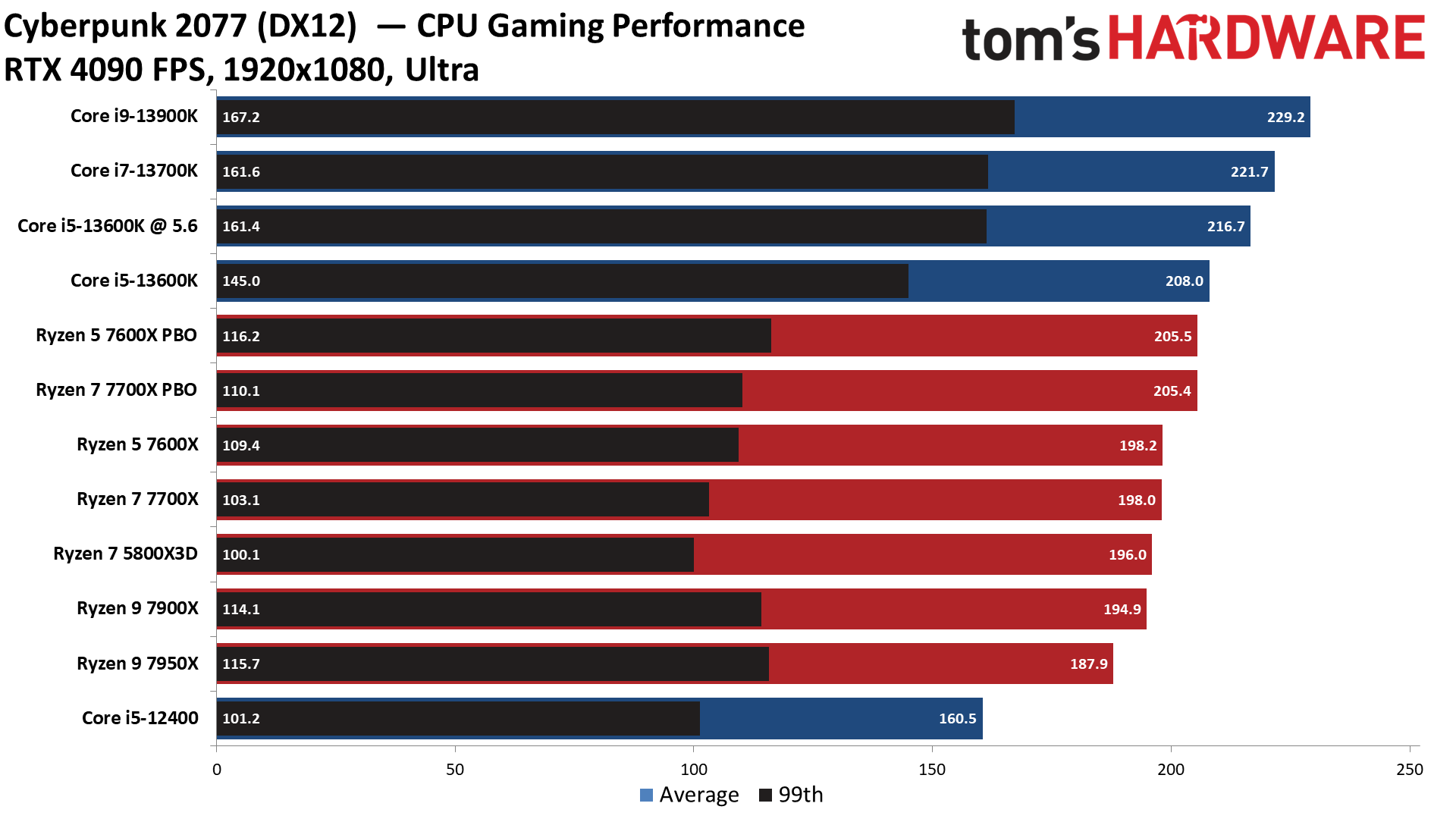













The $319 Core i5-13600K is 1.6% faster than the $349 Ryzen 7 7700X in our 1080p gaming suite, a difference that's made more meaningful by the $30 price differential (before we factor in platform costs). Also, the Ryzen 9 and 7 series of chips offer roughly the same gaming performance, with a mere two fps separating the three most powerful models, so the 13600K beats the Ryzen 9 lineup, too, if only by a small amount. Meanwhile, the 13600K is 6.4% faster than the $249 Ryzen 5 7600X. Notably, if you opt for DDR4 with the 13600K, you'll lose a few percentage points of performance, on average (see our testing here).
The Core i5-13600K also has impressive overclocking headroom that pushes the chip to 5.6 GHz, while the Ryzen chips are best overclocked using the auto-tuning Precision Boost Overdrive (PBO) feature. After overclocking, the 13600K is 3% faster than the overclocked Ryzen 7 7700X, and 7.6% faster than the tuned Ryzen 5 7600X.
Moving over to 1440p pushes the bottleneck more towards the GPU, so the difference between the chips shrinks. For example, at 1440p, the 13600K is basically the same as the Ryzen 7 7700X at stock and 3.7% faster after tuning both chips. Meanwhile, the 13600K is 3.4% and 6.5% faster than the stock and overclocked Ryzen 5 7600X configs, respectively.
AMD's fastest gaming chip comes in the form of the previous-gen $365 Ryzen 7 5800X3D, which is 8% faster than the 13600K at stock settings, but basically tied after we overclock the 13600K. Unlike the 5800X3D, the 13600K offers a more balanced profile that doesn't result in severe tradeoffs in productivity apps, either. Also, be aware that the Ryzen 7 5800X3D doesn't accelerate all game titles equally, so be sure to do your research. AMD does have its Ryzen 7000 X3D models coming to market, which could change the pecking order soon.
Be aware that large deltas in individual game titles, as we see with the 5800X3D, impact cumulative measurements. The Nvidia RTX 4090 delivers the largest gen-on-gen increase in GPU compute power in recent history, so we could see a wave of game optimizations to fully exploit the increased resources. That means these results could change, and as always, the AMD vs Intel competition can vary based on the title and the GPU you use, so it's best to make an informed decision based on the types of titles you play frequently. Be sure to check out the individual tests in the above album.
Winner: 13600K Tie with 7700X, 13600K Win over 7600X
Here we have a tale of two competitions. The Core i5-13600K is roughly the same as the Ryzen 7 7700X in gaming at both 1080p and 1440p resolutions but is $30 less and gives the option for value-centric DDR4 memory to reduce platform costs. In terms of performance, you can't go wrong with either chip. However, the Core i5-13600K has the edge in the price-to-performance department. We'll still score this as a tie between the Core i5-13600K and Ryzen 7 7700X.
The difference between the Ryzen 5 7600X vs Core i5-13600K results in a much more clear-cut win, with the 13600K taking a more meaningful performance lead. However, the Ryzen 5 7600X costs 22% less and is only 6% slower than the 13600K, making an argument for a value alternative. However, as we'll cover below, the higher price associated with DDR5 scuttles the value prop — you could opt for a graphics-less 13600KF and go with DDR4 memory instead.
Productivity Performance: Intel Core i5-13600K vs AMD Ryzen 7 7700X and Ryzen 5 7600X
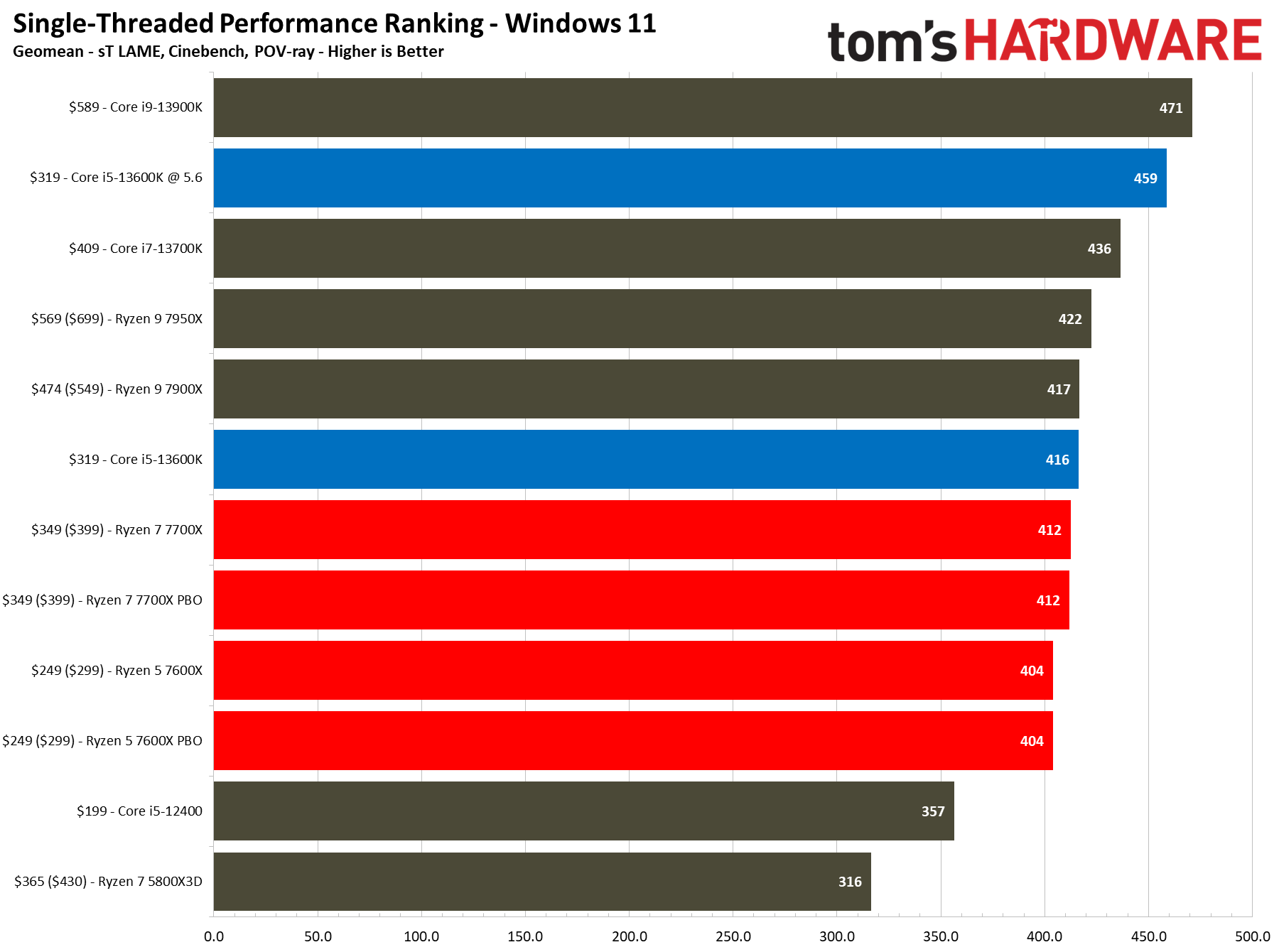


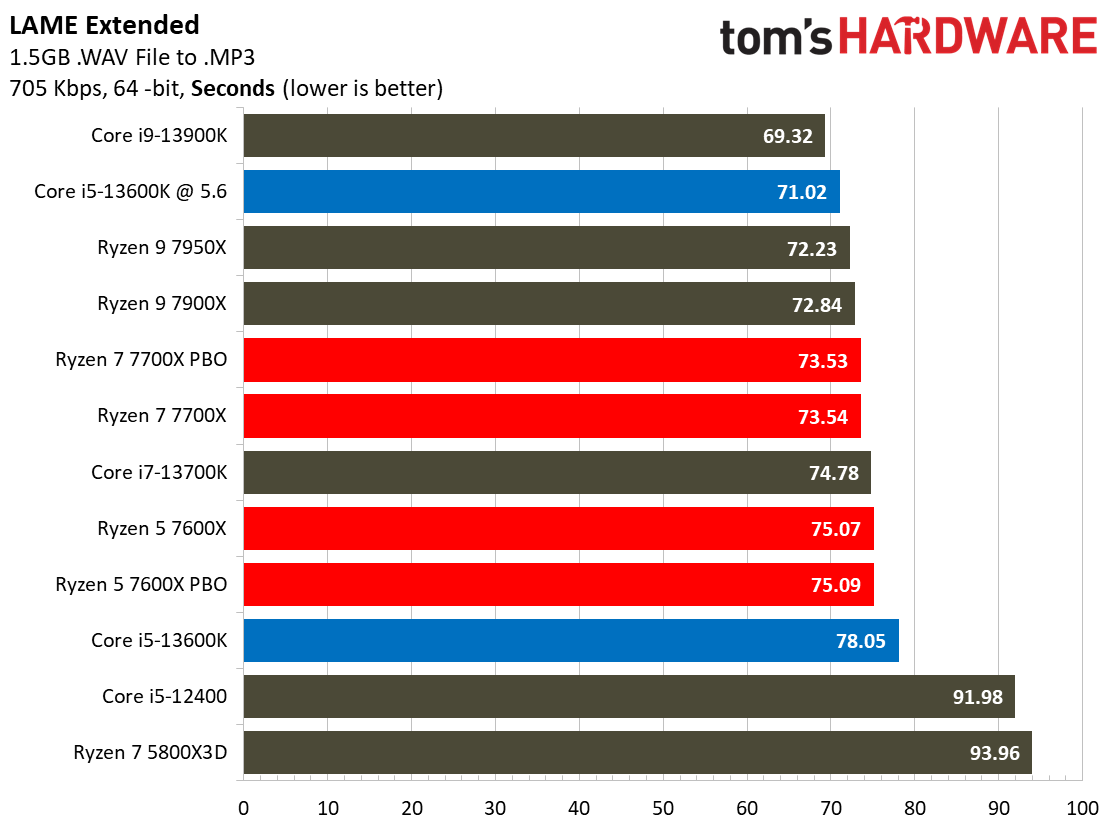








We can boil down productivity application performance into two broad categories: single- and multi-threaded. The first slide above shows the geometric mean of performance in several of our most important tests in each category, but be sure to look at the expanded results in the above album.
The Core i5-13600K vs Ryzen 7 7700X roughly tie in the overall measure of single-threaded performance, but the 13600K is 11.4% faster after overclocking. The 13600K is 3% faster than the Ryzen 5 7600X at stock settings, a small lead, but that expands to 13.6% after overclocking.
Naturally, those performance deltas won't carry over to every type of workload. However, flipping through the album of test results reveals that the Core i5-13600K vs Ryzen 7 7700X competition can be close in this type of work, and the Ryzen chips lead in the AVX-512 y-cruncher benchmark.

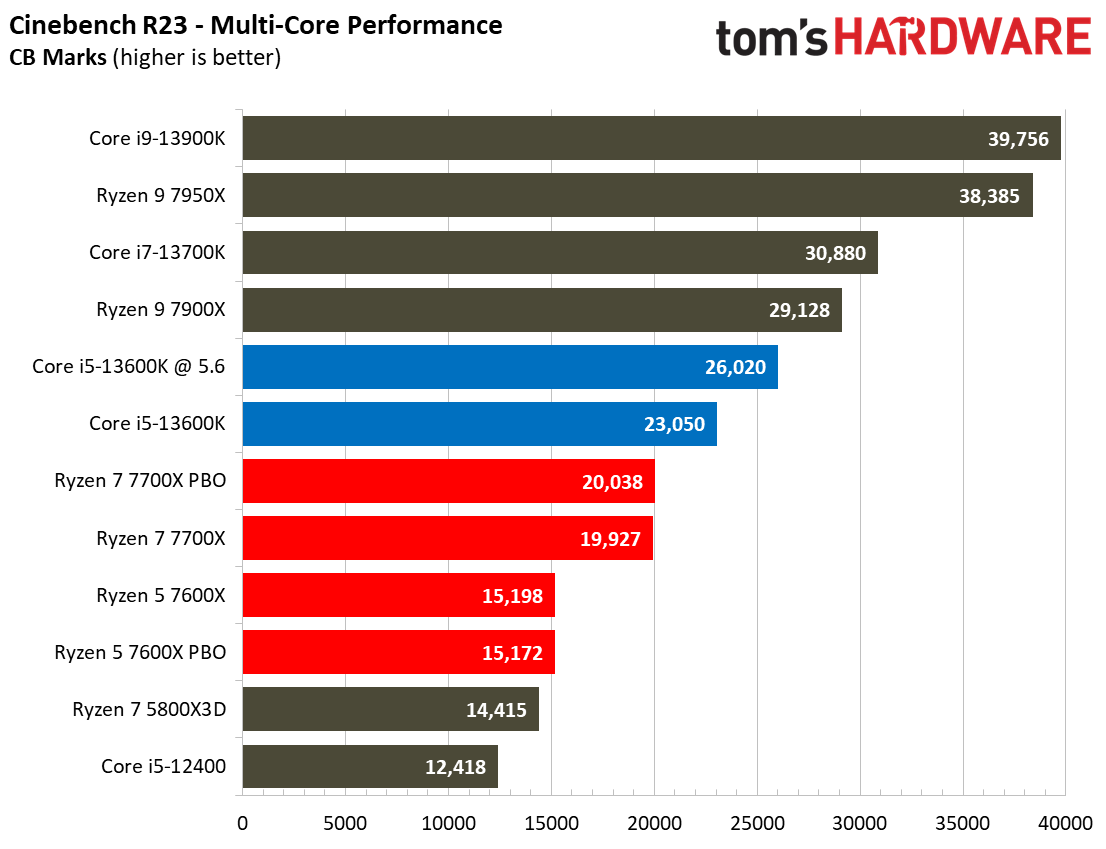



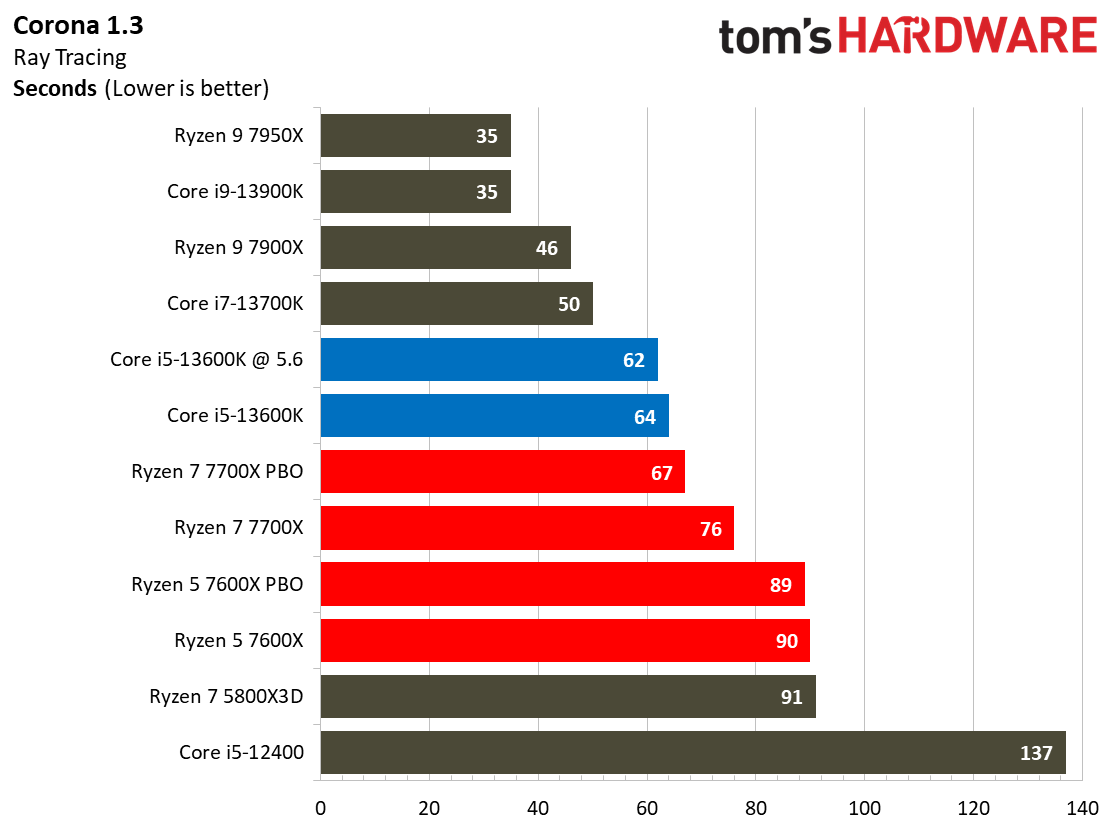


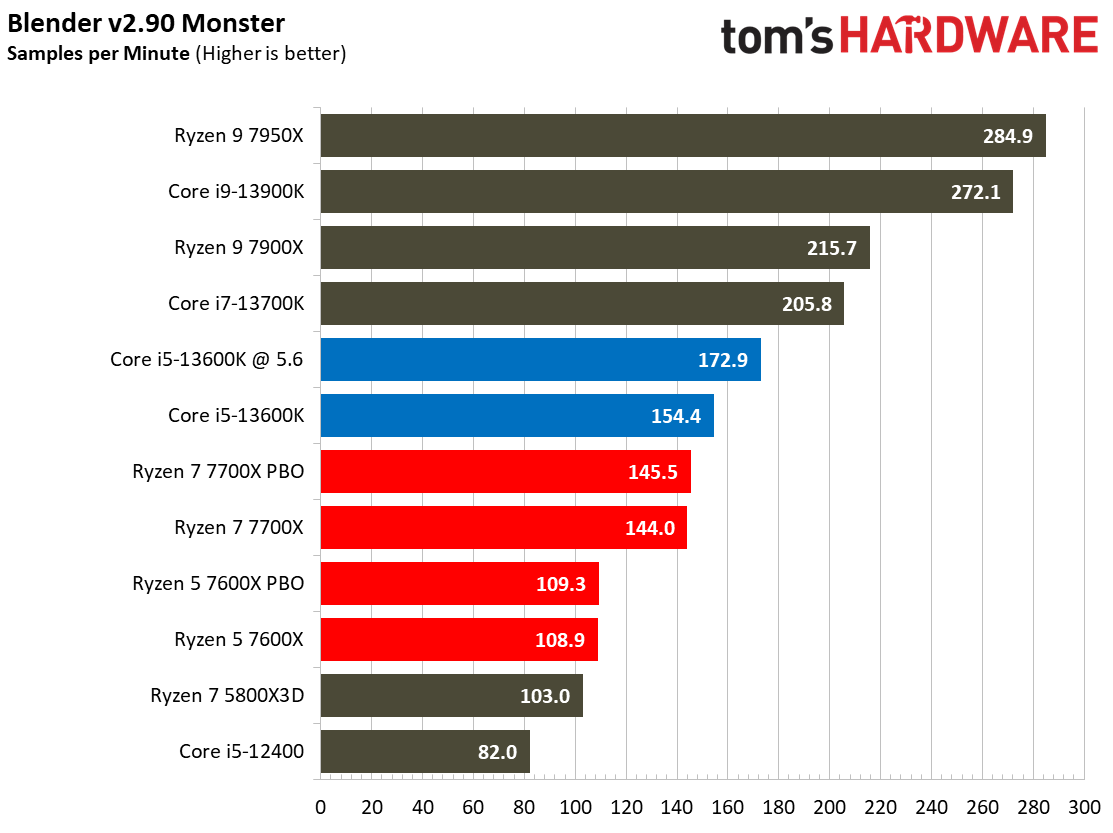


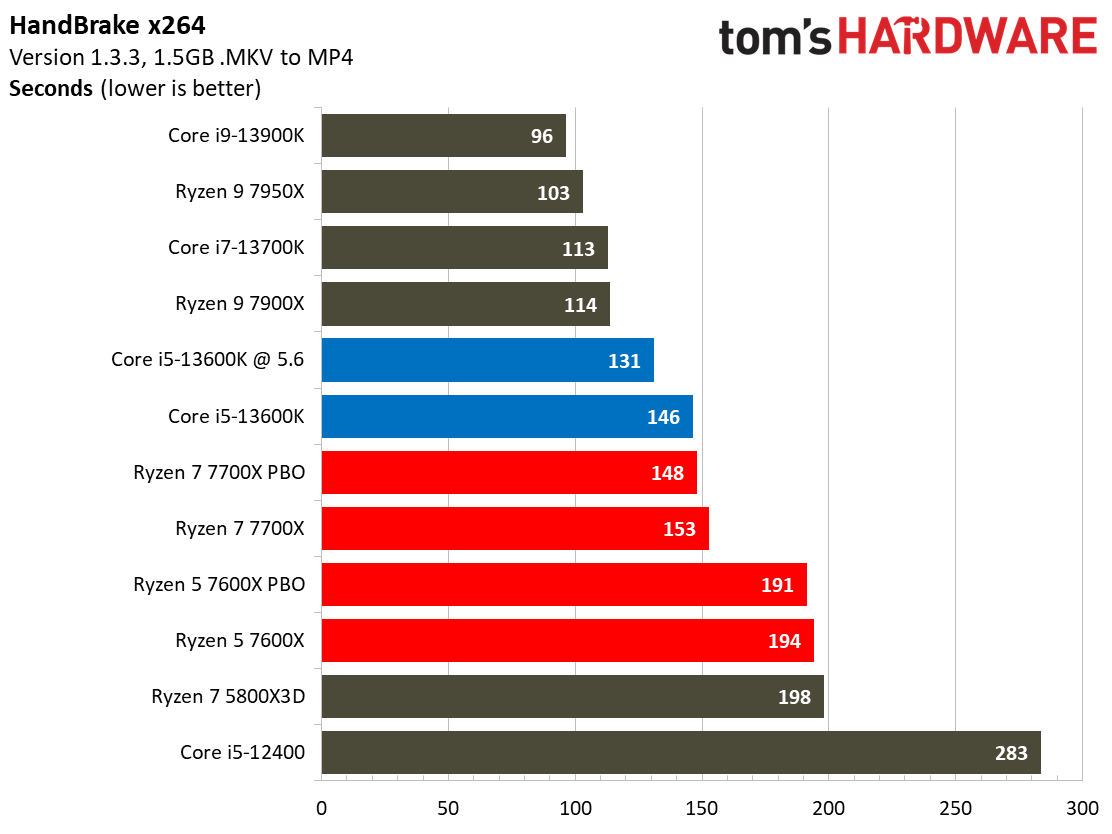

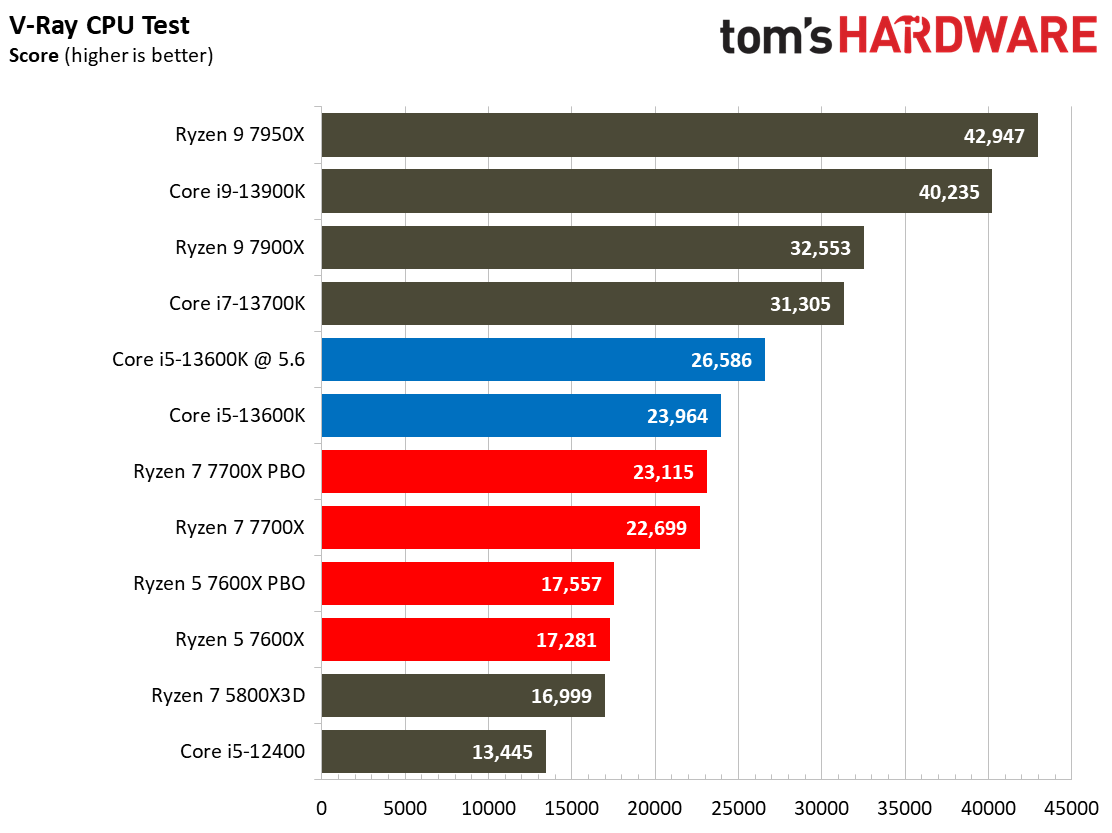





In multi-threaded work, the $319 Core i5-13600K is 8.5% faster than the $349 Ryzen 7 7700X at stock settings and a whopping 18.7% faster after overclocking. The Ryzen 5 7600X vs Core i5-13600K battle yields an even more convincing win for Raptor Lake, with the 13600K taking a 39% lead at stock and a 53% lead after overclocking.
Winner: Intel
The Ryzen 7 7700X and Ryzen 5 7600X vs Core i5-13600K competition is close in single-threaded work, but the Core i5-13600K proves its mettle in multi-threaded work.
Get Tom's Hardware's best news and in-depth reviews, straight to your inbox.
AMD's Ryzen 7000 uses hardware acceleration to speed AVX-512 workloads, an advantage over Raptor Lake in an increasing number of heavily-threaded tasks, but these continue to be fairly rare for the majority of users. Given its overall superior blend of performance in productivity applications, the Core i5-13600K takes the win.
Overclocking: Intel Core i5-13600K vs AMD Ryzen 7 7700X and Ryzen 5 7600X
We have long since reached the land of diminishing returns for overclocking the highest-end chips from AMD and Intel, like the Ryzen 9 and Core i9 families. Because AMD has pulled Intel into a dogfight for performance superiority on the high end, much of the overclocking frequency headroom is rolled into standard stock performance.
Luckily, you'll find larger overclocking gains with the downstream models, like the Core i5-13600K, Ryzen 7 7700X, and Ryzen 5 7600X we have in our faceoff today.
Intel and AMD expose a wealth of tunable parameters and sophisticated software overclocking utilities like XTU and Ryzen Master. They also support per-core frequency and hyper-threading control (enable/disable) to help eke out more overclocking headroom.
| Overclocking %age gain over stock | Core i5-13600K @ 5.6 GHz, DDR5-6800 | Ryzen 7 7700X PBO, DDR5-6000 | Ryzen 5 7600X PBO, DDR5-6000 | Row 0 - Cell 4 |
| Gaming (1080p) | 8.7% | 7.2% | 7.6% | Row 1 - Cell 4 |
| Single-Threaded | 10.3% | flat | flat | Row 2 - Cell 4 |
| Multi-Threaded | 11.7% | 2.1% | 1.3% | Row 3 - Cell 4 |
As usual, overclocking performance gains can boil down to your luck in the silicon lottery. As you can see above, overclocking both the memory and the cores does deliver tangible gains for the Core i5-13600K across gaming, single- and multi-threaded work. Meanwhile, the AMD processors both profit handsomely in gaming from tuning, but gains in multi-threaded work are muted, and we see no real uptick in single-threaded applications.
Intel has long restricted overclocking to its pricey K-series models, while AMD freely allows overclocking with all SKUs on almost any platform. However, we see some improvement here from Intel, as it has now enabled memory overclocking on its B- and H-series chipsets.
The 7950X and 13900K come with innovative boost technology that largely consumes most of the available frequency headroom, though Intel does have room for higher all-core overclocks. Unfortunately, all-core overclocking with AMD's chips is lackluster; you're often better off using its auto-overclocking Precision Boost Overdrive 2 (PBO2) feature that boosts multi-threaded performance. AMD also has plenty of Curve Optimization features that leverage undervolting to increase boost activity.
Intel's Raptor Lake chips are constrained by heat output — we obtained a 5.6 GHz overclock on the P-cores and a 4.0 GHz overclock on the E-cores, but we've seen that 5.7 GHz is common with 360mm AIOs or custom watercooling setups. We're sure a better cooler would allow us to push even further, but we stuck with our standard cooling setup (280mm AIO) to represent what a regular user could easily achieve.
Winner: Intel
Intel's Raptor Lake Core i5-13600K offers solid performance gains from overclocking in all three facets of work — gaming, single- and multi-threaded workloads all benefit from the 5.6 GHz peak clock rate we were able to achieve. Dedicated tuners will be able to push even higher, too. AMD's Ryzen processors deliver great gains in gaming from overclocking but don't offer meaningful upside in productivity applications, giving Intel the win.
Both platforms have a wealth of tunable parameters for enthusiasts, their respective overclocking advantages, and a suite of auto-overclocking and software utilities. Of course, dedicated tuners could find larger performance boosts by overclocking the core, fabric, and memory more aggressively than we have, but bear in mind that when it comes to overclocking, you're always at the whims of the silicon lottery.
Both companies have their advantages: Intel has the highest peak overclocking frequencies we've ever seen but restricts full overclockability to K-series chips and Z-series motherboards. AMD allows overclocking on all but its X3D model and A-series motherboards but has lower peak frequencies. That means this contest will often boil down to personal preference.
Power Consumption, Efficiency, and Cooling: Intel Core i5-13600K vs AMD Ryzen 7 7700X and Ryzen 5 7600X










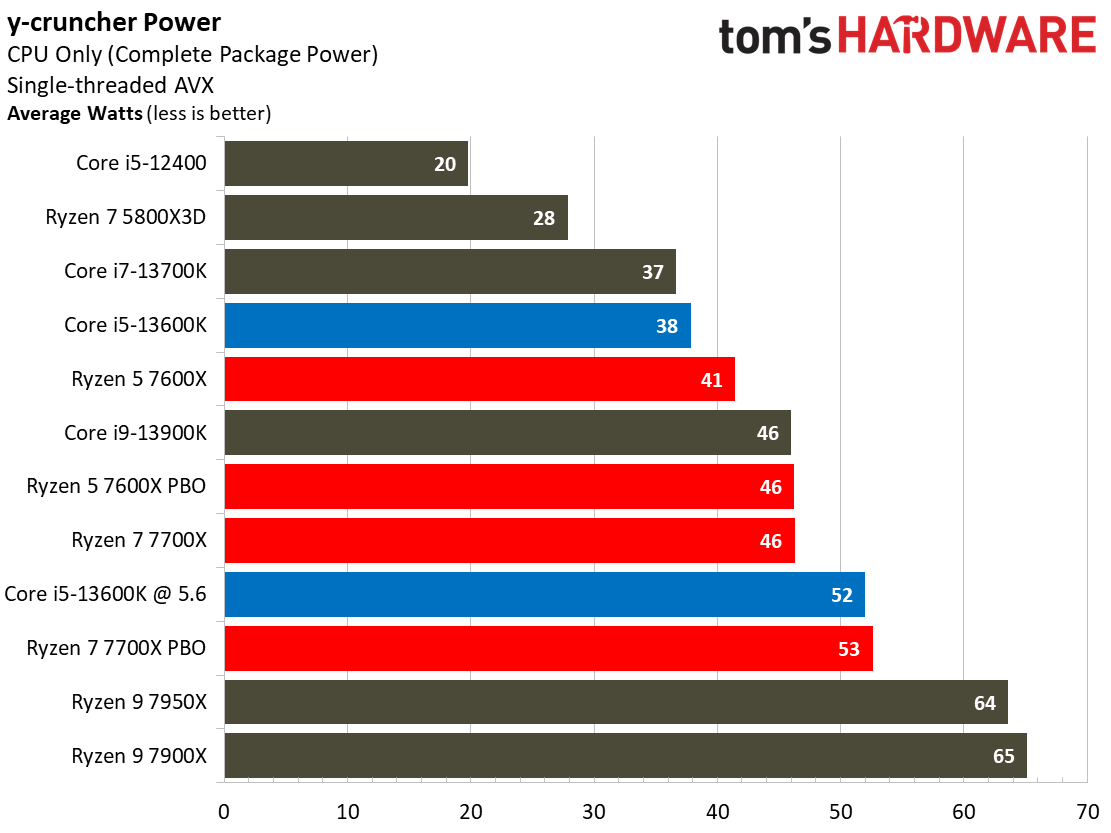


AMD has cranked up its power consumption to keep Ryzen 7000 competitive, but Raptor Lake still sucks more power. Overall, the Zen 4 architecture paired with the TSMC 5nm process is more efficient than Intel's fifth revision of the 'Intel 7' process and the x86 hybrid architecture.
Raptor Lake consumes more power than Alder Lake, but it is also much faster than its predecessor, earning it some leeway. Nevertheless, as we see in our renders-per-day measurements, AMD still holds the advantage in efficiency and all key power criteria. Intel's system consumes more power, resulting in higher thermal output.
Winner: AMD
Intel has made plenty of progress, but AMD still holds the crown of the most power-efficient chips. Not only do they suck less peak power, but they also accomplish more work per unit of power consumed. That results in a win in power consumption, efficiency, and thermal output, so you'll end up with a cooler and quieter system.
None of the chips in our AMD Ryzen 5 7600X vs Intel Core i5-13600K vs Ryzen 7 7700X faceoff come with a bundled cooler, but Raptor Lake's higher power consumption means you'll need a beefier cooler than you will for Ryzen.
Pricing: Intel Core i5-13600K vs AMD Ryzen 7 7700X and Ryzen 5 7600X
The Core i5-13600K has impressive performance for its $319 price tag, and you can even go graphics-less to save some cash with the $294 Core i5-13600KF model. That's competitive pricing against both AMD's $349 Ryzen 7 7700X and $249 Ryzen 5 7600X, which the 13600K rivals or beats in all but power consumption metrics.
There are a few caveats: The Ryzen 7 7700X has a suggested $399 price tag, while the Ryzen 5 7600X is officially $299. However, you can currently find these chips for about $50 less. AMD tells us it is currently running a holiday promotion, but these chips have maintained this pricing for about a month. AMD’s suggested pricing often has little to do with reality, so we think we’ll continue to see these chips in this price range. You should keep this in mind and check current pricing, but we'll use the lower pricing for our calculations.
Despite the reduced pricing, the Ryzen chips face other challenges that come in the form of high memory and motherboard pricing. We dove in deep on those issues here.
The price range of the Core i5 and Ryzen 7 and 5 chips means they are best suited for the B-series motherboards, but you'll need a Z-series board to overclock the Intel processor. You can find DDR5 Z790s for similar pricing to AMD's B-series, but your selection will be a bit more limited. You can also find a plethora of DDR4 Z790s for similar or lower pricing to AMD's B650, as well.
Raptor Lake is also compatible with previous-gen motherboards if they have the right BIOS, and performance will be the same between 600- and 700-series if the power delivery is identical. That means you could choose a DDR5 Z690 motherboard that offers nearly all the same amenities as the Z790 and have plenty of options that are actually cheaper than AMD's B-series motherboards (Z690 dips as low as $159 for both DDR4 and DDR5).
Intel's B660 is also an option, but it is a previous-gen product and doesn't allow overclocking (there are a few exceptions, but they tend to be pricey). Intel's new B760 lineup isn't expected for another few weeks, and it is rumored to come with a 10% increase in pricing over the existing B660 models. In either case, Intel users interested in using a B-series motherboard would probably be best with purchasing a locked model early next year.
Finally, the pricing advantage of DDR4 is simply too much to ignore, especially with lower-tier systems in this price range. While the premium for DDR5 has receded, you’ll still pay up to twice as much for a DDR5 kit as for DDR4, and AMD doesn't support the latter. For Raptor Lake, the slim performance advantage of DDR5 certainly doesn’t justify the extra price for DDR4, at least not for most users. Additionally, perhaps the best memory kit is the one you don’t have to buy — many upgraders likely already have a DDR4 kit, which is a plus.
Winner: Intel 13600K over 7700X — Tie with 7600X
AMD's Ryzen 7 7700X is more competitive against Intel's Core i5-13600K after the recent price cuts, but it is still $30 more even though it ties in gaming and trails in productivity applications. Overall, the Core i5-13600K clings to the pricing advantage over the Ryzen 7 7700X, even after AMD's recent price cut.
The high cost of AMD's B-series motherboards means you can find similarly-priced DDR5 Z790s for the 13600K, though options won't be as robust, or opt for a Z690 variant to save some cash (be sure to assure BIOS compatibility). You can also opt for a DDR4 motherboard to save even more cash, but you will sacrifice a few percentage points of performance in gaming (application performance remains similar).
The high price premium for DDR5 also continues to be a sticking point even for a higher-tier Ryzen 7 build, and that doesn't make it easy for the Ryzen 5 7600X to serve as a value alternative to the 13600KF. However, the recent price cut is welcome, so we score the Ryzen 5 7600X vs Core i5-13600K price battle as a tie.
Bottom Line: Intel Core i5-13600K vs AMD Ryzen 7 7700X and Ryzen 5 7600X
| Row 0 - Cell 0 | Intel Core i5-13600K | AMD Ryzen 7 7700X | Ryzen 5 7600X |
| Features and Specifications | X | X | X |
| Gaming | X | X | Row 2 - Cell 3 |
| Productivity Applications | X | Row 3 - Cell 2 | Row 3 - Cell 3 |
| Overclocking | X | Row 4 - Cell 2 | Row 4 - Cell 3 |
| Power Consumption, Efficiency, and Cooling | Row 5 - Cell 1 | X | X |
| Pricing | X | Row 6 - Cell 2 | X |
| Total | 5 | 3 | 3 |
The Core i5-13600K vs Ryzen 7 7700X and Ryzen 5 7600X battle ends in a five-to-three win in Intel's favor, though each of the Ryzen chips has its own distinct advantages and disadvantages in our different categories.
If you're interested in gaming only and you're chasing the highest performance in this general pricing bracket, you can't go wrong with either the $319 Core i5-13600K or the $349 Ryzen 7 7700X — they offer nearly the same gaming performance. However, the 7700X does come with a pricing premium.
The Ryzen 5 7600X trails the 13600K by 7% in gaming, but it retails for 22% less, making an argument as a value alternative. Instead, however, you could opt for a graphics-less $294 Core i5-13600KF and DDR4 memory and come out ahead on performance. Additionally, Intel's locked processors arrive in January. At that time, we expect the Core i5-13400 to vie for the value crown. Likewise, AMD is rumored to have its non-X models coming to market soon, so be sure to check the current state of the market if you're on the hunt for a budget build.
The Ryzen processors offer nearly the same performance as the 13600K in single-threaded applications, but the 13600K takes an 8.5% lead over the Ryzen 7 7700X and an 18.7% lead over the Ryzen 5 7600X in threaded applications, granting it the win in productivity apps.
Overclocking is becoming increasingly less interesting on the high end for most enthusiasts, but you'll still find impressive performance gains in the mid-range and low-end of the market. The Intel and AMD processors both provide solid uplift in gaming after overclocking, but the AMD chips don't deliver any gains in single-threaded work and only ~2% in multi-threaded applications. Meanwhile, the Core i5-13600K delivers ~10% more performance in both types of work, thus getting the nod in the overclocking category.
AMD's Ryzen 7000 still holds the advantage in all power consumption metrics, including peak power and efficiency, resulting in more forgiving cooling requirements and a cooler and quieter system. However, AMD has increased its power consumption significantly with this generation, so the advantage isn't as pronounced as we've seen in the past.
Pricing continues to be an issue for AMD's Ryzen 7000. Intel's very aggressive pricing gives it the overall lead against AMD's competing Ryzen 7000 chips, even after AMD's recent unofficial price adjustments. That applies even more so if you're building a DDR4 system. AMD only supports DDR5 memory, so you won't have the option for lower-priced memory like you do with the Raptor Lake processors. DDR4-equipped motherboards also tend to be less expensive, too.
AMD has suffered from high pricing for motherboards, and most of that difference occurs in the lower-end B-series motherboards that are the best fit for a chip of this class. You'll need a Z-series motherboard to unleash the 13600K's overclocking prowess, but you can find DDR5 Z790s for similar pricing to AMD's B-series, though your selection will be a bit more limited in that price range. You can also find a plethora of DDR4 Z790s for similar or lower pricing to AMD's B650, and you even have the option to step back to prior-gen 600-series boards and save some cash (just make sure you have the right BIOS).
Overall, the Core i9-13600K comes out ahead on the strength of its balanced performance in both gaming and productivity applications paired with impressive overclocking and lower overall platform costs.
- MORE: Best CPUs for Gaming
- MORE: CPU Benchmark Hierarchy
- MORE: AMD vs Intel
- MORE: Zen 4 Ryzen 7000 All We Know
- MORE: Raptor Lake All We Know
- MORE: All CPUs Content
| Intel Socket 1700 DDR5 (Z790) | Core i9-13900K, i7-13700K, i5-13600K |
| Row 1 - Cell 0 | MSI MPG Z790 Carbon WiFi |
| Row 2 - Cell 0 | G.Skill Trident Z5 RGB DDR5-6800 - Stock: DDR5-5600 | OC: XMP DDR5-6800 |
| AMD Socket AM5 (X670E) | Ryzen 9 7950X, Ryzen 9 7900X, Ryzen 5 7600X |
| Row 4 - Cell 0 | ASRock X670E Taichi |
| Row 5 - Cell 0 | G.Skill Trident Z5 Neo DDR5-6000 - Stock: DDR5-5200 | OC/PBO: DDR5-6000 |
| Intel Socket 1700 DDR5 (Z690) | Core i5-12400 |
| Row 7 - Cell 0 | MSI MEG Z690 Ace |
| Row 8 - Cell 0 | G.Skill Trident Z5 DDR5-6400 - Stock: DDR5-4400 | OC DDR5-6000 |
| AMD Socket AM4 (X570) | Ryzen 9 5950X, 5900X, 5700X, 5600X, 5800X3D |
| MSI MEG X570 Godlike | |
| Row 11 - Cell 0 | 2x 8GB Trident Z Royal DDR4-3600 - Stock: DDR4-3200 | OC/PBO: DDR4-3800 |
| All Systems | Asus RTX 4090 ROG Strix OC |
| Row 13 - Cell 0 | Gigabyte GeForce RTX 3090 Eagle - ProViz applications |
| Row 14 - Cell 0 | Nvidia GeForce RTX 2080 Ti FE - Application tests |
| 2TB Sabrent Rocket 4 Plus, Silverstone ST1100-TI, Open Benchtable, Arctic MX-4 TIM, Windows 11 Pro | |
| Cooling | Corsair H115i, Custom loop |
| Overclocking note | All configurations with overclocked memory also have tuned core frequencies and/or lifted power limits. |

Paul Alcorn is the Editor-in-Chief for Tom's Hardware US. He also writes news and reviews on CPUs, storage, and enterprise hardware.
-
ManDaddio Wish these would be a good pair with a 4090. The performance is nice compared to last gen. The 13600k looks great at this price point.Reply -
lmcnabney It is interesting why the gaming results were so much different in this article versus the exact same head2head done here. The other site also shows the speed of the RAM used (6000 for AMD and 6400 for Intel).Reply -
zecoeco Reply
Yep.. and that's the reason why I don't trust Tom's benchmarks.lmcnabney said:It is interesting why the gaming results were so much different in this article versus the exact same head2head done here. The other site also shows the speed of the RAM used (6000 for AMD and 6400 for Intel).
Its either a high error margin or a bias, favoring intel in most benchmarks as I noticed.
If you're planning to buy a CPU, the best thing to do is to look for more than one review (at least 3) and build up a geomean in your mind, observing the relativity.
So this way you'll get more accurate results on how the CPU actually performs., narrowing the bias and other factors involved which could impact the accuracy of these benchmarks. -
jp7189 I noted something similar before here in another article, where the Intel platform used DDR5 in the performance section, and DDR4 in the price section.Reply -
Paul Alcorn Replylmcnabney said:It is interesting why the gaming results were so much different in this article versus the exact same head2head done here. The other site also shows the speed of the RAM used (6000 for AMD and 6400 for Intel).
Thanks for reading. There are a myriad of reasons that we can see differences between various websites, including test setups, titles, and specific sequences used for comparison. Other factors, like drivers, power settings, and cooling can all impact test results. That's part of the reason why it is best to check several websites before you pull the trigger.
Also, you can check roundups where data from multiple reviews is combined to create a broader view. For instance, this one is comprised of 28 reviews and 6,710 benchmarks:
173
3D Center Review RoundupThis is the link to the source of the image, and you'll find a link to the reddit thread in the second tweet of that thread, as well. That will provide you with the raw data from each website in a table format.
I think 3DCenter does the community a great service with these comparisons, and I encourage folks to reference them as a general indicator of what to expect. You can also use them to benchmark our benchmarks, as it were.
We disclose our test hardware and procedures in the table at the end of the article. For our standard config, all chips are tested at stock memory settings, using the warrantied data rate to assure a level playing field and the best view of what you would see if you use the chip out of the box. I think the review cited only uses overclocked memory configurations.
We also test in overclocked configurations that use faster memory, and they're in our charts as well. As listed in our test setup section, the Ryzen chips tap out at DDR5-6000, as per AMD's own guidance that's the sweet spot, while we stopped at DDR5-6800 for Intel to remain in the general pricing vicinity for OC. However, Intel can hit over DDR5-8000 with XMP kits that we have full access to. They are just too expensive to be considered rational IMO.
All of our testing uses DDR5, though we do link to Raptor Lake DDR4 testing and mention multiple times that this can cost around a 4% performance loss, on average. We also reference both DDR4 and DDR5 pricing in all the relevant areas. -
lmcnabney Replyzecoeco said:Yep.. and that's the reason why I don't trust Tom's benchmarks.
Its either a high error margin or a bias, favoring intel in most benchmarks as I noticed.
If you're planning to buy a CPU, the best thing to do is to look for more than one review (at least 3) and build up a geomean in your mind, observing the relativity.
So this way you'll get more accurate results on how the CPU actually performs., narrowing the bias and other factors involved which could impact the accuracy of these benchmarks.
There are just so many different ways to inadvertently (or deliberately) cripple a benchmark run. Something as easily missed as not enabling XMP in the board will result in the motherboard running speedy RAM at much lower than rated speeds / latencies. Is the main board introducing some inefficiencies? The benchmarks here don't list the full criteria of the test setup, so you can't see if there is something unexpected going on. Do AMD CPUs perform poorly here because the RAM is DDR 4800 when everyone knows that 6000 is the sweet spot? I don't know. I would like to trust the review sites more than I do now. -
Paul Alcorn Replylmcnabney said:There are just so many different ways to inadvertently (or deliberately) cripple a benchmark run. Something as easily missed as not enabling XMP in the board will result in the motherboard running speedy RAM at much lower than rated speeds / latencies. Is the main board introducing some inefficiencies? The benchmarks here don't list the full criteria of the test setup, so you can't see if there is something unexpected going on. Do AMD CPUs perform poorly here because the RAM is DDR 4800 when everyone knows that 6000 is the sweet spot? I don't know. I would like to trust the review sites more than I do now.
Please read my response in the post above yours. Also, we test with both stock and OC'd RAM, and those results are in our performance charts as well. The settings are listed in the test setup table in the article. -
DavidLejdar Nice comparison of the cheaper current-gen CPUs. And Intel sure offers more options at the moment, such as being able to use a Z690 MB, one may already have with DDR4, to upgrade the CPU with.Reply
Myself, I recently upgraded from a DDR3 rig, and went for DDR5. Which is not specifically needed for gaming (as even DDR3 still works). But from what I understand, DDR5 should work better with a many-cores CPU than DDR4 does. And my gaming time goes mostly on simulations, open-world games, and strategies, with use-cases such as modding Cities: Skylines to allow for more than 9 tiles to build in, where even 9 tiles can be quite demanding on hardware (possibly leading to lag, which has nothing to do with the GPU).
So I went for DDR5, with "just" a Ryzen 5 7600X for the time being though - and I will eventually upgrade the CPU to possibly one with 3D V-Cache later.
The other option would have been for me to save a bit by going for a DDR4 rig instead, and to use the saving on a better GPU. But as there are some GPUs which can handle 1440p gaming above 100 FPS, at way below the current top prices for some other GPUs, I didn't see much a point in going for a higher tier. And as can be seen in the benchmarks, other hardware does have an impact on the performance of the GPU. And I didn't want to end up getting the GPU bottlenecked, to then throw out a DDR4 MB already after a few months or so.
Sure often boils down to personal preference in any case. I.e. someone wanting top-notch now, they will likely go for Intel, and probably also 4090, to be able to enjoy the reflections on the walls and floors in Portal with RTX. Or someone, who may not care much for the newest game releases, they have a lot of cheaper previous-gen options to build a rig with. And so on.
lmcnabney said:It is interesting why the gaming results were so much different in this article versus the exact same head2head done here. The other site also shows the speed of the RAM used (6000 for AMD and 6400 for Intel).
E.g. for Red Dead Redemption 2, 7600X came out on top here in the benchmarks too, while it performed worse for Watch Dogs Legion in both cases. The sample of games isn't as broad here though. And one could argue that TH having used DDR5-6800 (mentioned here) for the Intel CPU, in comparison to DDR5-6400 on the linked website, that such was a factor about test results, and that such factor speaks for Intel currently, as it goes beyond what AM5 offers (which would also imply that with DDR4, it would show worse results). And the linked article does mention better productivity performance of the 13600K, which is in accordance with what it says here. So I don't really see a problem. Nothing wrong with checking more than one review of course though. -
lmcnabney Reply
Thank you so much for your reply. This is an example of why I do want to trust your reviews because you are clearly trying to meet the needs of your audience. A lot of work goes into providing benchmark details. Countless hours of fairly tedious work. That effort is appreciated.PaulAlcorn said:https://forums.tomshardware.com/attachments/screenshot-2022-12-18-113042-png.173/
The chart above shows a current mystery which isn't really clear. The 7XXX CPUs are not scaling with gaming performance. I understand how increasing the cores wouldn't help and I do understand how there is an issue with only a single chiplet being used in some circumstances, but AMDs chips are raising the boost as they go up in bin just like Intel but they aren't showing increases in performance going above 7700X. Is there some type of cap being introduced on the AM5 platform which some setups are being impacted, but other setups are not? -
Thunder64 This one seems more fair then articles like this in the past. Intel benefits on the lower end because of the E-cores. I am glad that there is a new thread here to post in. Maybe you heard about my complaints in another thread, one of which was that I could not not have any input as to what was wrong. Here is what I wrote, and for the article I cited I think it was pretty damning. As I said, this one appears more fair.Reply
With Ryzen I do. Articles like this pop up fairly often, and I don't like the methodology. I'll go through it.
CPU Pricing and Value: Intel. No problems wit this. Though with the recent price cuts, It's probably a tie.
Gaming Performance: Intel. I'm fine with this for now.
Content Creation/Productivity: Intel. Should be a tie. Intel wins single thread, AMD multi thread. After those first graphs there are six (!) graphs comparing Alder Lake to Zen 3, which is not relevant anymore.
Specifications: Intel. This looks like nothing more than a repeat of CPU Pricing and Value. In other words, just a way to give Intel another win.
Overclocking: Intel. This one is just a mess. First it is ALL Alder Lake vs Zen 3. Alder Lake can eat tons of power, so of course there is more headroom. It should be compared to Zen 4 since they have much closer TDP's. Also, all AMD CPU's are unlocked whereas with Intel you need a K CPU and Z chipset. That alone makes me say this one should go to AMD.
Power Consumption: AMD. It's closer now with Zen 4 but still a win for AMD.
Drivers and Software: Intel. Not sure what this is supposed to even mean. I do know I've never seen AMD win or tie in it though so it seems it's there just to get another win. Both are generally just fine with the occasional problem now and then. I'd call it a tie.
Process Node: AMD. I agree. Not sure why it really matters though. Maybe to throw AMD a bone?
Architecture: Tie. I'm fine with that.
Security: AMD. I don't think it really matters to most people. A lot of the exploits are more theory it seems. But, AMD does have less of them.
So by my count, I'd give Intel 5 because I'd remove Specifications as a duplicate. AMD would get 7 or 8 depending on whether I included pricing. I would consider throwing away security to make it 6 or 7.
Here's the best part though (and by that I mean worst), the comments section starts over two years ago and is closed! Therefore no one can point out the flaws like I just did. Intel wins 7-4. It's the truth. You can't challenge it. Content Creation and Overclocking are the worst by far, IMHO.